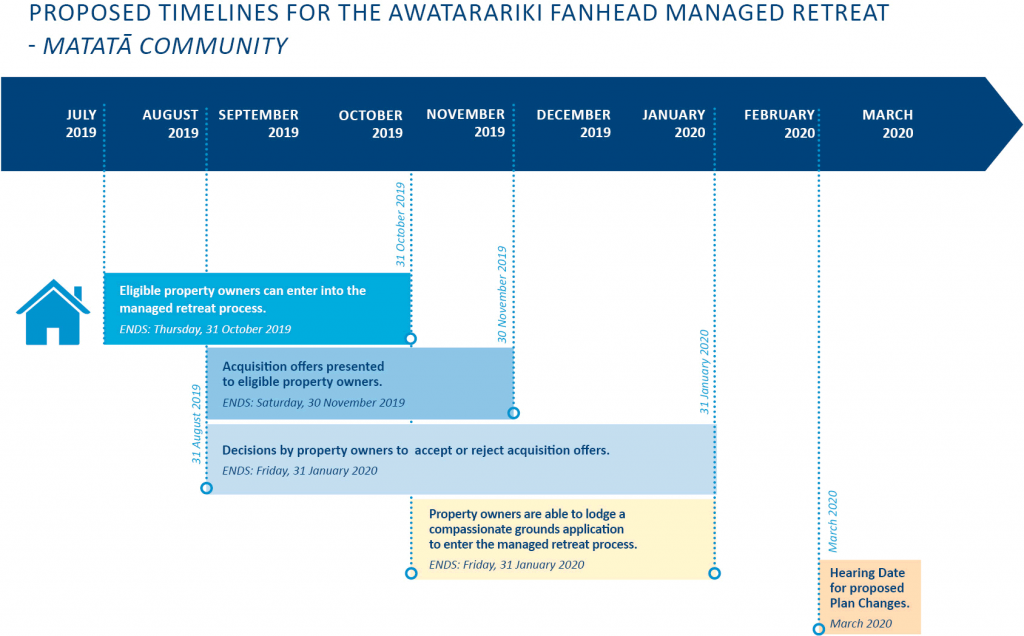On this page: Awatarariki Debris Flow 2005 | Whakatāne District Council's Legal Responsibility | Managed Retreat Package | Plan Changes
The purposes of the Awatarariki Managed Retreat Programme were to mitigate the risk to life and property from any future debris flow events from the Awatarariki Stream catchment, and to build disaster resilience factors for the Matatā community.
In July 2019, joint funding for a property acquisition package was agreed to by the Whakatāne District Council, the Bay of Plenty Regional Council, and the Department of Internal Affairs. The funding provides the financial resources to enable eligible property owners to relocate away from the Awatarariki debris fan at the western end of Matatā and bring an end to the uncertainty that property owners have had to live with since the debris flow event in 2005.
Awatarariki Debris Flow 2005
In May 2005, extremely heavy rainfall in the steep catchments behind Matatā caused a number of debris flows, which devastated much of the coastal township.
The debris flows were a mass of dense fluid with the consistency of wet concrete, containing rocks up to several metres diameter, together with trees, stumps, sand and silt, which flowed at speeds of up to 15-30 kilometres per hour from the Awakaponga, Awatarariki, Waimea, Waitepuru and Ohinekoao stream catchments. The debris flows and associated flooding cut major transport links, destroyed 27 homes, damaged 87 other properties, and caused $20 million in damage.
An investigation into the causes of the debris flows in 2005 by GNS Science confirmed they were a natural event triggered by exceptionally heavy rain.
The most destructive debris flow was from the Awatarariki Stream, at the western end of Matatā, where an estimated 300,000 cubic metres of debris was deposited on the fanhead. While there were no deaths on that occasion, the destructive force of this natural hazard was such that fatalities could easily have occurred.
Extensive research and analysis undertaken by a range of national and international experts showed that debris flows have occurred in this catchment in the past and will occur again in the future. These experts unanimously agree that the Awatarariki Stream fanhead is a ‘high-risk zone’ for future debris flows. The high-risk area includes 45 properties, 34 of which are in private ownership.
Debris Flows and Landslide Hazards
Whakatāne District Council's Legal Responsibility
Under the Bay of Plenty Regional Council's 'Regional Policy Statement - Natural Hazards', the District Council is legally required to take steps to reduce the high loss of life risk on the Awatarariki fanhead to a lower level (medium or lower, if practicable).
The District Council initially focused on developing an engineering solution, but following significant investigations, engineering experts advised that there were no viable engineering solutions, early warning systems or active managed processes that would reduce the risks.
In December 2012, after receiving this advice, the District Council agreed that the most effective way to reduce risks, meet its statutory requirements and provide the best options possible for locally-affected property owners, was through a managed retreat approach for properties in the high-risk area.
In conjunction with the managed retreat approach, the District Council also proposes changes to the District Plan and Regional Natural Resources Plan. These changes give effect to the Regional Policy Statement requirement to identify and reduce high natural hazard risk. The proposed outcomes of the plan changes are to alter the zoning of the land from residential to coastal protection to reflect the natural hazard risk, and to remove its ability to be used for residential purposes.
Managed Retreat Package
The retreat package supported eligible property owners and Matatā community members through a range of assistance measures, including:
Purchase package: offers for eligible property owners
The managed retreat package provided offers to eligible property owners for the purchase of their properties at a fair, current market value (supported by market evidence), with no discount made for the known hazard/risk.
The retreat package also provided contributions towards legal fees, relocation costs (for residents whose fanhead property is their primary place of residence) and mortgage break fees (if applicable).
Eligible property owners had the choice to take up the offer of the Managed Retreat Package (which was made on the basis of a one-time offer) or not. Eligible property owners were provided opportunities for individual discussions about the acquisition package, proposed settlement and timeframes to suit their needs (as achievable within the below timeframes for the package).
Read the Frequently Asked Questions »
Navigator support
The District Council appointed two Navigators Chris King-Hazel and Vicky Richards - who both have extensive experience in this type of role. They worked with eligible property owners to understand their individual needs and provide them with practical assistance and access to information and available services.
This included ensuring owners have access to:
- Independent free legal advice through the Residential Advisory Services, to help them to understand the package and make informed choices about their options;
- A range of services, including financial advice and counselling services.


Chris King-Hazel and Vicky Richards
The Navigators could access additional support and resources to meet individual property owners’ needs. Participation and uptake of these services was voluntary and confidential. All eligible property owners were encouraged to use these services.
Community engagement
The District Council is also working to ensure the Matatā community, ratepayers and interest groups are kept informed about the Managed Retreat Programme and the transition process.
In the future, the District Council will work closely with the Matatā community and other interest groups regarding the potential use of the open space which could be created by the purchase of properties. This may provide an opportunity to establish environmental and disaster protection zones, as well as passive recreational spaces.
Plan Changes
The rules around where residential development can take place are contained within the Whakatāne District Plan. In order to prevent future residential development in the areas of high hazard risk on the Awatarariki Fanhead, the District Council publicly notified a proposed change to the District Plan.
As the District Plan cannot change existing rights to prevent the use of land for an established use, the District Council has lodged a plan change to Regional Natural Resources Plan prepared by the Bay of Plenty Regional Council. This would prevent residential activities from continuing on existing built sites.
The District Council jointly consulted prior to the notification of the proposed plan changes in 2018. Eight submissions on each plan change have been received. A hearing for submissions was set for March 2020 and an independent Hearing Panel was appointed to hear the submissions and determine the plan changes. Submitters were able to present evidence at the hearing and appeal the decisions of the independent Hearing Panel to the Environment Court.

